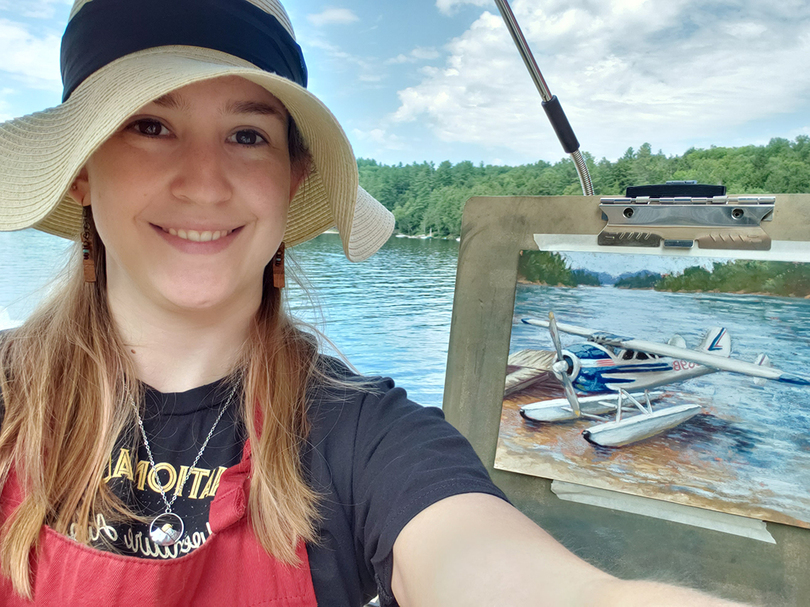Online shows, social media display artists’ work during pandemic

Courtesy of Catherine LaPointe Vollmer
Local artist Catherine LaPointe Vollmer has found ways to continue painting during the COVID-19 pandemic.
The Daily Orange is a nonprofit newsroom that receives no funding from Syracuse University. Consider donating today to support our mission.
Sam Jividen wanted to expand the online marketplace for his interactive art show business, Canvisi, when local art businesses had to scale down at the beginning of the COVID-19 pandemic.
Since July, Canvisi has hosted three online art shows in Rochester, Syracuse and Buffalo and has two more planned for Washington, D.C., and Cleveland. Jividen was impressed by the turnout at the shows, with around 3,200 people coming to the Syracuse-focused event.
Online art shows and social media are two of the many methods by which artists have been able to show off their talents during the COVID-19 pandemic.
“When the pandemic kicked off, in the art crafting community pretty much every one of our shows got canceled almost immediately,” said Nina Kalinkos, owner of Eclectic Clay.
Canvisi, a streaming platform for creators, is where Jividen believed art shows were already heading before COVID-19, he said, but the pandemic sped up the transition.
When the pandemic kicked off, in the art crafting community pretty much every one of our shows got canceled almost immediately.Nina Kalinkos, owner of Eclectic Clay shop
During the virtual shows hosted by Canvisi, artists are allotted a timeslot to livestream from their homes or studios. Artists can do an art demonstration, give a short discussion about their work or be interviewed by Kalinkos, Jividen said.
It’s rare to actually see inside an artist’s studio to see what they’re working on, Kalinkos said.
As an artist, Kalinkos draws inspiration from a wide range of interests, so interviewing artists has been a valuable experience and bolstered her appreciation for other artists’ crafts.
When the pandemic forced New York state into quarantine, Kalinkos already transitioned to working primarily from home since she gave birth to her second child less than a year ago. But she never strays far from her polymer clay.
“It’s a thing I need to live as a person,” Kalinkos said.
Catherine LaPointe-Vollmer also finds inspiration in her craft as a post-impressionist artist focusing on nature and landscapes.
“Nature has been my inspiration,” LaPointe-Vollmer said. “ I live out in the country, so there is frequently a variety of wildlife in my yard.”
Despite canceling her trip across the U.S. this summer, LaPointe-Vollmer dedicated this summer to improving her plein air painting skills by participating for a few weeks in the Adirondack Plein Air Festival, she said.
As stores closed and arts shows were recently canceled, LaPointe-Vollmer has seen an uptick in her online sales.
For Marc Safran, the pandemic forced him to close down his photography studio at the Delavan Center in Armory Square. Safran is an eye surgeon by trade, but he has become an avid photographer over the last 20 years.
Normally, Safran goes to Ecuador every summer on a surgical trip, and during his spare time he photographs patients. Whether he’s photographing his family or his patients, he loves taking pictures of peoples’ faces. But that has changed during COVID-19.
He recently shot some studio work and has noticed that inquiries for his services are increasing again. But, in the meantime, Safran is taking time to reflect on his older work and organize them into a book.

Artist have relied on their virtual fanbase to get critiques on their art. Courtesy of Catherine LaPointe Vollmer
“So while I didn’t work in the studio I did a lot of editing at home. Reviewing, reviewing, collating and calling out my better stuff,” Safran said. “It gave me a chance to work in the past as opposed to just worried about the future.”
Photographer Laura Thorne has utilized quarantine to write a book and focus more time on her photography Instagram page, @absolute.reVolution.gallery, a “52-week mission” for Thorne.
Thorne started the project to teach amateur photographers the fundamentals of photography, especially how to improve composition, through weekly challenges.
In quarantine, Thorne has learned to find the unique aspects of the places she took for granted. Throne interacts with her followers often. Her followers are starting to become her friends, rather than just people on the screen.
“I wouldn’t still be doing it if they weren’t telling me (their feedback),” Thorne said. “It’s really engaging for them.
As the second year of “missions” concludes, she said she will take some time to plan something bigger and better, hopefully running more missions that show how global her following is.
And for amatuer artists just looking to get into an art craft on their own, Safran said, “If you want to get good at something you have to keep plugging away at it. Feel free to make lots of mistakes, and feel free to make victories.”





